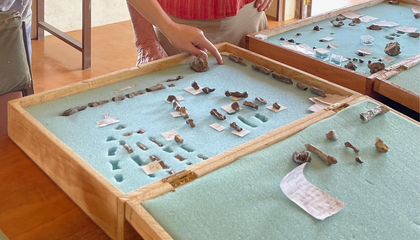Science
Discovery of Fossil Hand Links P. Boisei to Tool Use

Recent research has unveiled the first fossilized hand attributed to *Paranthropus boisei*, suggesting that this ancient hominin may have possessed the ability to use tools. The findings, published on October 5, 2023, by a team from the University of Kent and the National Museums of Kenya, cast new light on the behavior of our evolutionary relatives.
The fossil, estimated to be around 1.8 million years old, was discovered in East Africa, an area known for its rich archaeological significance. This remarkable find adds a new layer to the ongoing debate about whether *P. boisei*, often characterized by its robust jaw and teeth adapted for chewing tough vegetation, might have also engaged in tool-making activities similar to those of early humans.
Research leader Dr. Mark Thomas from the University of Kent emphasized the importance of this discovery. “The fossil hand provides crucial evidence that *P. boisei* may have had the dexterity needed for tool use,” he explained. The hand structure suggests capabilities that could support the use of basic tools, which may have played a role in their survival and adaptation.
The implications of this discovery extend beyond mere physical characteristics. Understanding whether *P. boisei* used tools can reshape our comprehension of early hominin behavior and lifestyle. The findings challenge the long-held notion that only Homo species were capable of tool production.
Insights from the Fossil
The fossilized hand exhibits features that indicate a grip suitable for holding and using tools. The researchers noted the arrangement of the fingers, which suggests that *P. boisei* had the potential for precision grip, a trait necessary for manipulating objects. This capability aligns with what is observed in modern primates and early human ancestors who utilized tools for various tasks.
According to the National Museums of Kenya, the fossil was uncovered during excavations aimed at studying early hominin habitats. The site has yielded numerous other significant finds, but this fossil stands out due to its implications for understanding tool use.
Dr. Thomas highlighted the collaborative nature of the research, stating, “This discovery is a testament to the hard work of our team and the support from local communities.” The fossil’s excavation was supported by local guides and researchers, emphasizing the importance of community involvement in archaeological endeavors.
The Significance of Tool Use in Human Evolution
The question of tool use in early hominins is pivotal to understanding human evolution. Traditionally, tool-making has been viewed as a defining characteristic of our genus, *Homo*. If *P. boisei* did indeed use tools, it suggests that the cognitive and motor skills necessary for such behavior may have evolved earlier than previously thought.
Researchers are now keen to explore further evidence of tool use among other hominins. As studies continue, the fossilized hand of *P. boisei* may serve as a critical piece in the puzzle of human ancestry. The ongoing research also invites discussions on the ecological and social contexts in which these ancient relatives lived.
In conclusion, the discovery of the fossil hand linked to *P. boisei* opens new avenues for understanding the capabilities of our ancient relatives. As scientists analyze this find, the potential for revealing more about early hominin behavior grows, contributing to the broader narrative of human evolution.
-

 Health4 days ago
Health4 days agoRare Brain Condition Discovered More Common in New Mexico
-

 Politics5 days ago
Politics5 days agoPrince Andrew Steps Back from Royal Duties Following Epstein Memoir
-

 Health5 days ago
Health5 days agoRemembering Mary Ingleby: A Life of Love, Teaching, and Music
-

 Sports5 days ago
Sports5 days agoMLS Decision Day 2025: Playoff Spots on the Line as Teams Clash
-

 Science5 days ago
Science5 days agoIdaho State University Launches Haunted Science Laboratory on Oct. 25
-

 World5 days ago
World5 days agoYoung Driver Dies in Collision with Box Truck in El Cajon
-

 Lifestyle5 days ago
Lifestyle5 days agoKent Hamilton Named Southeastern Farmer of the Year at Expo
-

 Entertainment5 days ago
Entertainment5 days agoTrump Commutes George Santos’ Sentence, Sparks Controversy
-

 Politics5 days ago
Politics5 days agoNavy Veteran Max Quattromani Launches Campaign for Assessor Seat
-

 Sports5 days ago
Sports5 days agoSaquon Barkley Reacts to James Franklin’s Dismissal from Penn State
-

 Health3 days ago
Health3 days agoScientists Warn: Human Brain Struggles to Function After Midnight
-

 World5 days ago
World5 days agoHamas to Return Additional Hostage Remains on Friday









